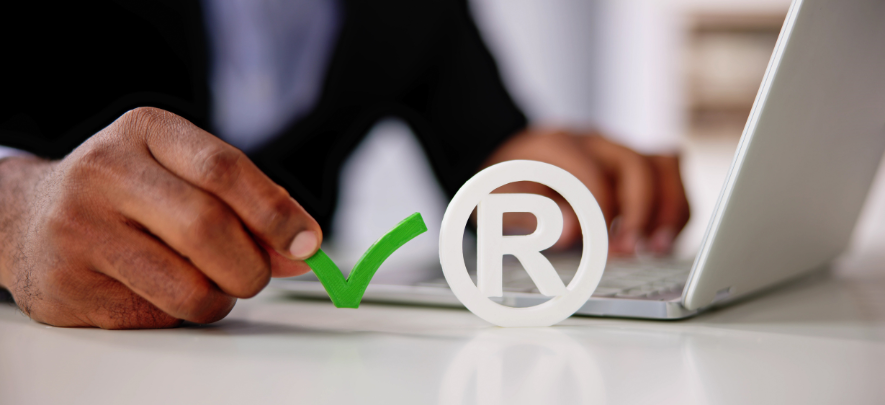Trademark Registration: Everything You Need to Know

Legal & Compliance
38 week ago — 11 min read
Trademark registration is an important step for businesses and individuals looking to protect their brand identity. A trademark can include a name, logo, slogan, or any combination of these elements that distinguishes your products or services from those of others. Registering your trademark provides legal protection and helps in building a unique brand identity that customers can trust.
What is a Trademark?
A trademark is a symbol, word, phrase, design, or a combination of these that identifies and differentiates the source of the goods or services of one party from those of others. It is a form of intellectual property that legally protects your brand from being used by others without permission.
Benefits of Trademark Registration
- Legal Protection: A registered trademark gives you exclusive rights to use the mark in connection with your goods or services, providing a legal basis to prevent others from using a similar mark.
- Brand Recognition: A trademark helps in building a recognizable brand, making it easier for customers to identify your products or services.
- Business Value: A registered trademark can become a valuable asset, contributing to the overall value of your business.
- Nationwide Coverage: Registration provides protection throughout the country, rather than being limited to a specific geographic area.
- Right to Use the ® Symbol: Once registered, you can use the ® symbol, indicating that your trademark is officially registered and protected by law.
The Trademark Registration Process
1. Conduct a Trademark Search
Before applying for trademark registration, it is crucial to conduct a thorough search to ensure that your desired trademark is not already in use. This can be done using online databases provided by the trademark office in your country.
2. Prepare the Trademark Application
The application process typically involves the following steps:
- Identify the Mark: Clearly describe the trademark you wish to register. This could be a logo, brand name, or a combination of elements.
- Specify the Goods/Services: Identify the goods or services that will be associated with the trademark.
- Choose the Class: Trademarks are categorized into different classes based on the type of goods or services. Ensure you select the appropriate class for your application.
3. File the Application
Submit the application to the relevant trademark office. This can usually be done online. The application should include:
- A representation of the trademark
- A description of the goods or services
- The appropriate class
- Payment of the application fee
4. Examination and Publication
Once the application is submitted, it undergoes examination by the trademark office to ensure it complies with all legal requirements. If any issues are identified, you may need to address them before the application can proceed.
If the application is approved, the trademark is published in the trademark journal. This publication allows others to oppose the registration if they believe it infringes on their existing trademarks.
5. Opposition Period
During the publication period, third parties have the opportunity to oppose the registration of your trademark. If no opposition is filed, or if opposition is resolved in your favor, the trademark proceeds to registration.
6. Registration and Maintenance
Once the opposition period is over and any issues are resolved, the trademark is officially registered, and a certificate of registration is issued. To maintain the trademark, you may need to file periodic maintenance documents and fees.
Tips for Successful Trademark Registration
- Choose a Unique and Distinctive Mark: Avoid common or descriptive terms that could be challenging to register and protect.
- Conduct a TM Search: Ensure your mark is not already in use to avoid conflicts and potential legal issues.
- Seek Professional Assistance: Consider consulting a trademark attorney to help with the complexities of the registration process.
- Monitor and Enforce Your Trademark: Actively monitor the market for potential infringements and enforce your trademark rights as needed.
Frequently Asked Questions (FAQs)
1. What is a trademark?
A trademark is a symbol, word, phrase, design, or combination of these that identifies and diffrentiates the source of the goods or services of one party from those of others. It is a form of intellectual property that legally protects your brand.
2. Why should I register my trademark?
Registering your trademark provides several benefits, including exclusive rights to use the mark, legal protection against infringement, enhanced brand recognition, and the ability to use the ® symbol. It also adds value to your business and provides nationwide coverage.
3. How do I conduct a trademark search?
A trademark search can be conducted using online databases provided by the trademark office in your country. These databases allow you to search for existing trademarks to ensure your desired mark is not already in use.
4. What is the difference between the ™ and ® symbols?
The ™ symbol can be used to indicate that you are claiming rights to a trademark, even if it is not registered. The ® symbol, on the other hand, can only be used once your trademark is officially registered with the trademark office.
5. How long does the trademark registration process take?
The trademark registration process can vary depending on the jurisdiction and the specifics of your application. Generally, it can take anywhere from several months to over a year, including the time for examination, publication, and potential opposition.
6. Can I register a trademark for free?
No, trademark registration typically involves fees for filing the application and maintaining the registration. The exact fees depend on the jurisdiction and the specifics of your application, such as the number of classes of goods or services.
7. What happens if someone opposes my trademark application?
If someone opposes your trademark application, you will need to respond to the opposition, providing arguments and evidence to support your case. The trademark office will then decide whether to approve or reject your application based on the arguments presented.
8. Can I register a trademark internationally?
Yes, you can register a trademark internationally through mechanisms such as the Madrid System, which allows for the filing of a single application to register a trademark in multiple countries. Alternatively, you can file separate applications in each country where you seek protection.
9. How long does a trademark registration last?
Trademark registrations typically last for ten years from the date of registration. They can be renewed indefinitely for additional ten-year periods, provided the required maintenance documents and fees are submitted on time.
10. What should I do if someone infringes on my trademark?
If you believe someone is infringing on your trademark, you can take legal action to enforce your rights. This may involve sending a cease and desist letter, negotiating a settlement, or filing a lawsuit. It is advisable to consult a trademark attorney for guidance.
11. Can I trademark a domain name?
Yes, you can trademark a domain name if it functions as a source identifier for your goods or services. The domain name must meet the requirements for trademark protection, such as being distinctive and not merely descriptive.
12. What is a trademark class?
A trademark class is a category of goods or services for which a trademark is used. Trademarks are classified into different classes based on the type of goods or services they represent. When filing a trademark application, you must specify the classes that apply to your trademark.
13. Can I change my trademark after it is registered?
Generally, you cannot change the fundamental elements of a trademark after it is registered. However, you can file a new application for the modified mark. Minor changes or corrections may be possible depending on the jurisdiction's rules.
14. What is the role of a trademark attorney?
A trademark attorney can assist you in the trademark registration process, conducting searches, preparing and filing applications, responding to office actions, and handling oppositions and enforcement actions. Their expertise can help ensure a smoother and more successful registration process.
15. Is trademark registration mandatory?
Trademark registration is not mandatory, but it provides significant legal benefits and protection. Without registration, your trademark rights are limited to the geographic area where the mark is used, and enforcing your rights can be more challenging.
16. Can I use my trademark while the application is pending?
Yes, you can use your trademark while the application is pending. However, you cannot use the ® symbol until the trademark is officially registered. You can use the ™ symbol to indicate your claim to the mark.
17. What is a trademark renewal?
Trademark renewal is the process of extending the protection of your registered trademark beyond its initial registration period. This involves submitting the required maintenance documents and fees to the trademark office before the expiration date.
18. What is a specimen in a trademark application?
A specimen is a sample of how the trademark is actually used in commerce. It is submitted as part of the trademark application to demonstrate that the mark is being used in connection with the specified goods or services. Examples include product labels, packaging, and website screenshots.
19. Can two businesses have the same trademark?
In some cases, two businesses can have the same or similar trademarks if they operate in different industries or geographic areas and there is no likelihood of confusion. However, it is generally advisable to choose a unique and distinctive mark to avoid potential conflicts.
20. What are the consequences of not registering a trademark?
If you do not register your trademark, you have limited legal protection and may face difficulties in enforcing your rights. Unregistered trademarks are typically protected only within the geographic area of use, and proving ownership and priority can be more challenging in legal disputes.
Also read
What Are the Trademark Classes for Trademark Registration?
What is the Cost of a Trademark for Small Enterprises?
How do you trademark a name globally?
What is the difference between Trademark ™ and Registered trademark symbol ® ?
To explore business opportunities, link with me by clicking on the 'Connect' button on my eBiz Card.
Image source: Canva
Disclaimer: The views and opinions expressed in this article are those of the author and do not necessarily reflect the views, official policy or position of GlobalLinker.
Posted by
Vivek RanjanI am working at Compliance Calendar LLP as Content Executive. Researching and writing content on various legal, tax and compliance topics are my key areas, and I am happy to add...
View Vivek 's profile
Most read this week










Comments
Share this content
Please login or Register to join the discussion